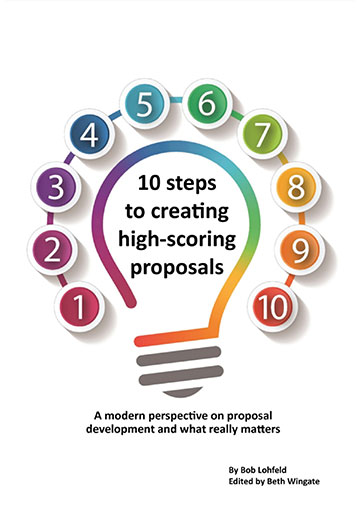Automated Tools Powering Growth Beyond AI Now

Automated tools are no longer optional in the GovCon industry—they are essential for staying competitive. While artificial intelligence dominates the conversation, many firms overlook the everyday technologies that drive business growth. From managing complex pipelines to streamlining capture strategies and producing winning proposals, automated tools are transforming how companies win work. For business development (BD), capture, and proposal professionals, the question isn’t whether to use these tools, but how to integrate them into a winning system.
Business Development: Turning Data into Action
Growth starts with identifying opportunities and building the right relationships. Automated tools give BD teams the power to anticipate, track, and act:
- CRMs (e.g., Salesforce, HubSpot, Microsoft Dynamics) – These platforms go beyond contact management. They automatically track touchpoints, forecast revenue, and flag stalled opportunities. With workflow automation, BD leaders can schedule recurring reminders for follow-ups or automatically push new opportunities into the pipeline when agencies release RFIs.
- Market Intelligence Platforms (e.g., Deltek GovWin IQ, Bloomberg Government, SAM.gov) – GovWin IQ, for instance, doesn’t just list opportunities; it pushes automated alerts when agencies publish new requirements in your NAICS codes or other descriptors, helping BD leaders react before competitors even notice. It also contains AI functionality to expedite operations.
- LinkedIn Sales Navigator – This tool automates lead targeting. Instead of cold outreach, BD professionals are armed with warm, data-driven entry points to support engagement with government customers.
Example: A mid-sized IT contractor automated its opportunity pipeline using GovWin IQ alerts tied to its core NAICS codes and other descriptors. Opportunities were fed directly into Salesforce, where workflow rules triggered agenda items for pursuit decision meetings.
Capture Management: Building Strategies Faster
Capture teams need speed, insight, and collaboration to shape solutions and craft winning strategies. Automated tools eliminate the friction of manual coordination:
- Knowledge Management Systems (e.g., SharePoint, Confluence) – Instead of digging through scattered folders, capture teams’ queries are organized in standardized repositories that tag past performance, resumes, and kudos.
- Collaboration Platforms (e.g., Microsoft Teams, Slack, Miro) – Integrated with scheduling and project management tools, these platforms automatically notify SMEs when inputs are due and allow virtual whiteboarding for solutioning sessions.
- Workflow Automation (e.g., Microsoft Power Automate, Zapier) – Capture managers can automate bid/no-bid approvals, generate recurring pipeline reports, and trigger executive review checkpoints.
- Competitive Intelligence Tools (e.g., GovWin, GovTribe, Capture2Proposal) – GovTribe, for instance, automatically updates competitors’ activity on your target opportunities, feeding capture plans with fresh intelligence.
Example: A capture manager used Microsoft Power Automate to generate weekly pipeline dashboards from Salesforce and email them to leadership. What took hours every Friday now runs automatically, allowing the capture team to focus on solution development rather than data wrangling.
Proposal Development: Speed, Compliance, and Quality
Proposals succeed when they are accurate, compliant, compelling, and filled with strengths across every evaluated criterion. Automated tools make this possible under tight deadlines:
- Proposal Management Platforms (e.g., Loopio, RFPIO, Qvidian, VisibleThread) – These tools automatically import RFP requirements, build compliance matrices, and generate document outlines. RFPIO, for example, uses content libraries to auto-populate boilerplate sections such as corporate capabilities, thereby reducing rewrite time.
- Graphic and Design Tools (e.g., Adobe Creative Suite, Canva, Microsoft PowerPoint, Billion Dollar Graphics) – Graphic and design tools are essential for turning text-heavy proposals into visually engaging documents that evaluators can quickly absorb. From Adobe Illustrator for precision graphics to InDesign for polished page layouts, these tools elevate proposals far beyond standard templates, helping contractors convey strengths and discriminators with impact and clarity.
- Collaboration Suites (e.g., Microsoft 365, Google Workspace) – Real-time co-authoring with automated version control ensures writers, SMEs, and reviewers never overwrite each other’s work.
- Language and Compliance Review Tools (e.g., CoPilot, Grammarly) – Grammarly for Business, for example, strengthens proposal writing by automatically checking for grammar, clarity, tone, and conciseness. It ensures drafts are polished, professional, and free of distracting errors, so evaluators focus on the solution—not the writing.
Example: A proposal team used Grammarly Business to review a 200-page technical volume before a final review. By catching many small grammar and clarity issues in minutes, the team presented reviewers with a cleaner draft. Instead of getting bogged down in wordsmithing, the review team was able to focus on improving strength statements and ensuring responsiveness to RFP requirements.
Conclusion
AI may capture the headlines, but the reality is that automated tools—from CRMs and workflow platforms to compliance checkers and design software—are the unsung heroes driving GovCon success. The firms winning today are those that build integrated ecosystems where BD, capture, and proposal tools work together to shorten pursuit cycles, strengthen strategies, and elevate proposal quality.
If your organization is ready to transform its growth engine, contact us today to learn how our experts can help you leverage automation to increase win rates and deliver high-scoring proposals that win contracts.
Relevant Information
By Brenda Crist, Vice President at Lohfeld Consulting Group, MPA, CPP APMP Fellow
Lohfeld Consulting Group has proven results specializing in helping companies create winning captures and proposals. As the premier capture and proposal services consulting firm focused exclusively on government markets, we provide expert assistance to government contractors in Capture Planning and Strategy, Proposal Management and Writing, Capture and Proposal Process and Infrastructure, and Training. In the last 3 years, we’ve supported over 550 proposals winning more than $170B for our clients—including the Top 10 government contractors. Lohfeld Consulting Group is your “go-to” capture and proposal source! Start winning by contacting us at www.lohfeldconsulting.com and join us on LinkedIn, Facebook, and YouTube(TM).
Paperback or Kindle
10 steps to creating high-scoring proposals
by Bob Lohfeld
contributors Edited by Beth Wingate
Subscribe to our free ebrief
Teaming friends, frenemies, and enemies—12 tips to mitigate harmful effects
Did you know that contracting officers spend up to 20% of their time mitigating disputes between teaming partners? In an informal poll we conducted on LinkedIn last month, 40% of respondents classified their teaming partners as “frenemies” on their last bid.
Explore Further
- Advice (539)
- AI (28)
- APMP (18)
- Army MAPS Contracts (3)
- Business Development (294)
- Capture Management (266)
- Complex Technology Grants Services (26)
- Favorite Books (5)
- GenAI (4)
- Go-to-Market (27)
- Graphics (5)
- Lohfeld Books (2)
- NASA SEWP VI Contracts (2)
- Navy SeaPort-NxG Contracts (2)
- NIST MSE Grants (1)
- NIST NAPMP Grants (2)
- Past Performance (63)
- Post-submission Phase (14)
- Pre-RFP Preparation (264)
- Proposal Management (339)
- Proposal Production (75)
- Proposal Reviews (38)
- Proposal Writing (107)
- Pursuit Phase (108)
- Research Report (4)
- Resources (63)
- Tools & Tips (421)
- Training (13)
- Uncategorized (223)

Sign Up for INSIGHTS and Download your FREE book
We'd love to help you with your proposals. Enjoy our complimentary Lohfeld Consulting Group Capture & Proposal Insights & Tips book with your FREE subscription to our Insights Newsletter.
GET YOUR FREE BOOK



